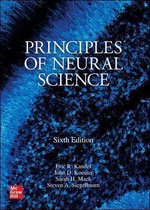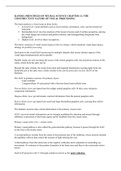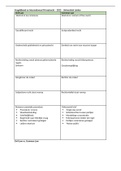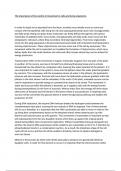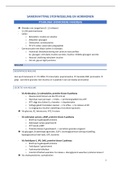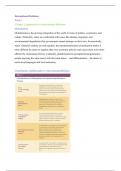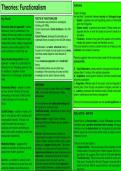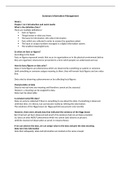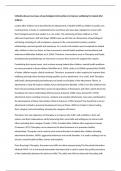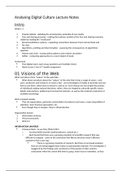KANDEL PRINCIPLES OF NEURAL SCIENCE CHAPTER 21: THE
CONSTRUCTIVE NATURE OF VISUAL PROCESSING
The brain analyzes a visual scene at three levels:
1. Lowest level: visual attributes such as local contrast, orientation, color, and movement are
measured.
2. Intermediate level: involves analysis of the layout of scenes and of surface properties, parsing
the visual image into surfaces and global contours, and distinguishing foreground from
background.
3. Highest level: involves object recognition.
The brain’s analysis of visual scenes begins in the two retinas, which transform visual input using a
strategy of parallel processing.
Each point in the visual field is processed in multiple channels that extract distinct aspects of the
visual input simultaneously and in parallel.
Parallel steams are sent out along the axons of the retinal ganglion cells, the projection neurons of the
retina, which form the optic nerves.
Beyond the optic chiasm, the axons from nasal and temporal hemiretinas carrying input from one
hemifield join in the optic tract, which extends to the lateral geniculate nucleus (LGN) of the
thalamus.
The LGN in primates consists of 6 primary layers:
- 4 parvocellular
- 2 magnocellular each paired with a thin but dense koniocellular layer.
Parvocellular layers get input from the midget retinal ganglion cells they carry red-green
component information.
Magnocellular layer get achromatic contrast information from the parasol ganglion cells.
Koniocellular layers get input from small and large bistratified ganglion cells, carrying blue-yellow
information.
The thalamic neurons relay retinal information to the primary visual cortex.
LGN’s received retinal information can be strongly modulated by attention and arousal through
inhibitory connections to this brain region and by feedback from the visual cortex.
Primary visual cortex (V1) = striate cortex.
Primary visual pathway is also called the geniculostriate pathway because it passes through the LGN
on the way to the striate cortex.
A second pathway extends from the retina to the pretectal area of the midbrain, where neurons mediate
the pupillary reflexes that control the amount of light entering the eyes.
A third pathway from the retina runs to the superior colliculus and is important in controlling eye
movements continues to the pontine formation in the brain stem and then to the extraocular motor
nuclei.
Each LGN projects to the V1 through a pathway known as the optic radiation.
CONSTRUCTIVE NATURE OF VISUAL PROCESSING
The brain analyzes a visual scene at three levels:
1. Lowest level: visual attributes such as local contrast, orientation, color, and movement are
measured.
2. Intermediate level: involves analysis of the layout of scenes and of surface properties, parsing
the visual image into surfaces and global contours, and distinguishing foreground from
background.
3. Highest level: involves object recognition.
The brain’s analysis of visual scenes begins in the two retinas, which transform visual input using a
strategy of parallel processing.
Each point in the visual field is processed in multiple channels that extract distinct aspects of the
visual input simultaneously and in parallel.
Parallel steams are sent out along the axons of the retinal ganglion cells, the projection neurons of the
retina, which form the optic nerves.
Beyond the optic chiasm, the axons from nasal and temporal hemiretinas carrying input from one
hemifield join in the optic tract, which extends to the lateral geniculate nucleus (LGN) of the
thalamus.
The LGN in primates consists of 6 primary layers:
- 4 parvocellular
- 2 magnocellular each paired with a thin but dense koniocellular layer.
Parvocellular layers get input from the midget retinal ganglion cells they carry red-green
component information.
Magnocellular layer get achromatic contrast information from the parasol ganglion cells.
Koniocellular layers get input from small and large bistratified ganglion cells, carrying blue-yellow
information.
The thalamic neurons relay retinal information to the primary visual cortex.
LGN’s received retinal information can be strongly modulated by attention and arousal through
inhibitory connections to this brain region and by feedback from the visual cortex.
Primary visual cortex (V1) = striate cortex.
Primary visual pathway is also called the geniculostriate pathway because it passes through the LGN
on the way to the striate cortex.
A second pathway extends from the retina to the pretectal area of the midbrain, where neurons mediate
the pupillary reflexes that control the amount of light entering the eyes.
A third pathway from the retina runs to the superior colliculus and is important in controlling eye
movements continues to the pontine formation in the brain stem and then to the extraocular motor
nuclei.
Each LGN projects to the V1 through a pathway known as the optic radiation.

